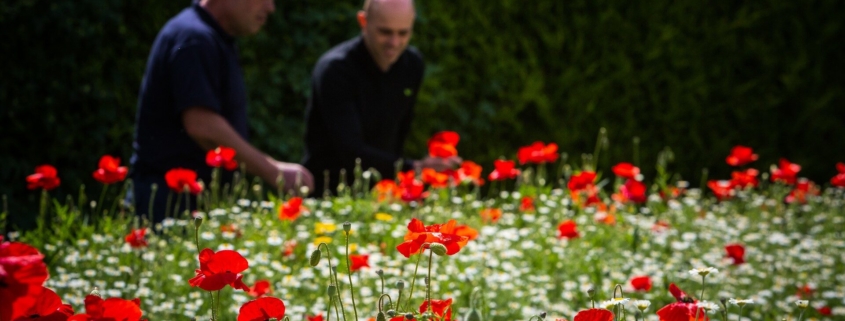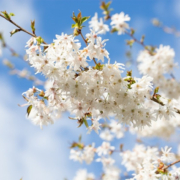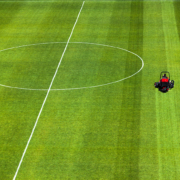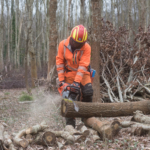How to choose the best wildflower seed mix
Interest in wildflowers has risen in the last few years. The main driver is the recognition of the plight of all invertebrates. In particular, bees and other pollinators, including moths. Alongside their visual appeal, wildflowers can play a vital role in supporting pollinators.

Lost wildflower meadows
The emphasis on what is an appropriate area and what constitutes a wildflower seed mixture has changed since the initial push to increase lost meadows back in the 1980s and ‘90s.
In those days, the main purpose behind establishing wildflowers was to replace meadows lost to heavy industry, such as mining, road construction and modern farming techniques.
Supporting pollinators
Today, the emphasis is on establishing wildflower seed in areas to provide habitats and food sources for pollinators. These areas can be of any size or location, such as roundabouts, schools, business parks or traditional meadows on large landscape schemes.

This new ethos of supporting invertebrates in urban, suburban and rural locations has provided a canvass for landscape architects and increased the type of acceptable wildflower seed mixtures.
Non-native species can also play a part in some wildflower mixtures to extend the flowering period. These species can also boost the number of flowers in a mixture as well as make the floral display even brighter.
Urban Meadows
These ‘Urban Meadows’ include species such as Calendula. Although more common in parks and gardens, selected non-native wildflowers are highly beneficial to pollinators and are perfectly suited to urban and suburban settings.

True Meadows
Of course, UK wildflower seed mixtures are still available for when a more traditional ‘True Meadow’ of only native species is desired. This approach is suitable when sowing wildflower seeds in rural areas or any site where there is a desire or requirement (perhaps overseen by an ecologist) to establish or re-establish a true meadow.

Native Meadows
However, it should be recognised that UK native meadows are largely grass and wildflower habitats that resemble hay meadows. Native meadows are hugely beneficial to all wildlife but replicate grazing habitats.
As such, they contain a high percentage of grass and offer less floral impact than mixes with non-native species. When specifying mixtures, landscape architects should explain this to clients whose perception of a wildflower meadow is likely to be a floral display.
The likes of the Fields of Gold at the 2012 Olympics or the Jubilee meadows contained many non-native species.
Which wildflower seed mixtures can be sown where?
For clarity, it’s better to describe these areas as wildflower areas rather than meadows. This shift in mindset helps prevent confusing ‘Urban Meadows’ with ‘True Meadows’. The consideration should be: What kind of area is appropriate? You might find a ‘true meadow’ fits the bill.
You should also decide your aim for the area. For instance, are you trying to create a 365-day-a-year habitat? Or do you want a food source for bees and pollinators and a floral display?
Ecological sites
For a 365-day-a-year habitat, then you need to establish a mix of wildflower and grass seed. In this case, you need to consider the constraints. If the area is an ecologically sensitive site, it’s likely that only a mixture of UK native wildflower seeds will be appropriate.
If the National Vegetation Classification (NVC) of the area is known, then a mixture to match that would be the best choice. A mixture such as RE1 Traditional Hay Meadow would replicate an MG5 grassland.
However, if the NVC is not known, an ecological survey might be required to assess the species needed in the mix. A site-specific mixture can then be developed, or those species identified can be matched to an off-the-shelf mix.
Suburban and urban sites
In a suburban or urban setting, a mixture of grass, UK native wildflowers and some non-native species can be established. WFG2 Flowering Meadow is a prime example of a mix combining those three elements.
Once established, WFG2 will offer an impressive floral display while serving as a meadow by providing a grassland habitat. Urban parks or housing estates would be ideal locations for sowing these wildflower seeds.
Floral displays and pollinators
To establish a floral display providing a food source for pollinators, a 100% mixture of annuals or a combination of annual and perennial species can be considered.
Often, these mixtures contain selected non-native species and excel in urban and suburban areas. This is because they provide the floral impact expected by the wider public while benefitting wildlife.
WF19 Pollinator Paradise is the best wildflower seed mix for these settings, especially smaller areas in retail car parks or on roundabouts. Alternatively, a mix of cornfield annuals wildflower seeds can be chosen if you need UK native species.
WF10 Cornfield Annuals can be highly effective in this case. Please bear in mind, however, that UK native cornfield annuals aren’t always suitable for every site. If you require specialist advice, then please speak to an ecologist.
If you want maximum floral impact but are concerned about the impact on habitats, you should consider the following. Firstly, is the area large enough to serve both purposes? To clarify, you could establish a mix of grass and wildflowers in one area and a floral display in another.
A mix like WFG2 Flowering Meadow could be sown in a larger area where informal recreation is enjoyed. Then there could be a high-impact display established on smaller sections of the site, scheme or project.
Secondly, is there a habitat close by? There could be a large area or motorway verge left uncut and managed infrequently. By sowing a high-impact mix, you can provide an extra food source for wing invertebrates.
Does soil type impact wildflower seeds?
Determining the soil type of your site will also have an impact. Urban meadow mixtures are generally suited to more fertile soils, including imported topsoil. Meanwhile, true meadow mixtures typically prefer poor, low-fertility soils. The vast majority of soils are suitable for these mixes.
 In extreme cases of soil conditions, careful mixture selection is needed. Acid grassland communities can be established on a soil pH as low as 4 and limestone mixtures on a soil pH of up to 9-10.
In extreme cases of soil conditions, careful mixture selection is needed. Acid grassland communities can be established on a soil pH as low as 4 and limestone mixtures on a soil pH of up to 9-10.
Is a wildflower mixture the correct choice at all?
It always helps to consider if a wildflower mix is appropriate at all. Often the specification of a mixture comes from a good place, a desire to create habitat and boost biodiversity.
However, if sited in the wrong place, establishing a wildflower meadow can prove to be a false economy. When deciding whether to sow wildflower seeds, you should consider the factors below.
Aesthetics
Although beautiful when flowering, wildflowers can look scruffy during autumn, winter and spring. A wildflower grass seed mix looks like a weedy lawn once cut late in summer and remains this way until growth begins in March or April. More floral mixes can look even sparser over the winter.
There will also be a point when wildflowers grow up to 80 cm. Running up to the time of cutting, wildflower areas can look brown and lodge over. These mixes aren’t always suitable for high-profile facades such as office frontages.
If established in the wrong setting, wildflowers can be misunderstood and subsequently replaced with a conventional grass seed mixture at a further cost. This situation can arise through a decision to cover all BREEAM credits required for a project by specifying a wildflower meadow. Landscape architects should guard against this impulse.
Expectation
As mentioned, some meadows have greater floral appeal than others, with urban meadows being the most impactful. Having said that, the flowering display of any mix can be limited from April to August. Depending on the weather, the floral display can begin earlier or end later.

The display will of course change throughout the months as some species finish and others begin. It should be remembered that in a year the display is quite a short period of time. This is not out of keeping with our natural environment, but we sometimes put unrealistic expectations on sown areas.
Steep embankments
Wildflower seed establishes slowly, and the root system doesn’t develop quickly enough to be relied on to stabilise steep embankments. For embankments steeper than 45%, stabilising matting is needed.
Even with matting, it can be tricky to establish seeds as embankments dry out quickly and the soil has already been compacted to form the bank. In these situations, the mixture specification process should focus on rapid establishment.
One mixture ideally developed for steep banks is A18 Road Verge and Embankments. A18 can offer quick establishment and the inclusion of DoubleRoot clover improves soil structure. DoubleRoot can also feed the grass in the mix and offer a food source for pollinators from the cover flowers.
A18 can also be managed with a low-intensity strategy. Just one to two cuts per year will allow the growth of common species such as Yarrow, Dandelions, Hawkbit species and Lady’s bedstraw.
The cost of maintaining wildflowers
It’s often suggested that wildflower meadows are cheaper to maintain than closely mown grassland. This belief comes from meadows only needing to be cut once or twice a year. But, it’s not that simple and the acceptance of higher initial costs is an important reality when attempting to establish species.
When sowing a true wildflower meadow, you should view it as resetting an equilibrium. The meadow you are trying to recreate will have taken years to develop naturally. Therefore, extra maintenance should be expected for up to five years after sowing.
Soils either imported or on-site will contain weed species such as Dock leaves, Fat hen, Charlock and Nettles and will grow in the wildflower meadow. Thus, a degree of invasive weed control should be expected. Weeds may need to be spot sprayed or hand-pulled while the area develops a balance of species.
Strimming and removing clippings can also be more costly than regular mowing. If larger areas are cut in stages, as recommended in our management guide, then return visits are needed.
Suitable Sites for wild flora mixtures
- Road verges
- Golf courses
- Parks and country parks
- School and college campuses
- Retail parks
- Business parks
- Domestic gardens
There are numerous opportunities, but three things hold the key to success:
- Choosing the best wildflower seed mixture for the area
- The right attention to seedbed preparation and sowing – especially when sowing wildflowers into grass
- The subsequent maintenance and cutting regime
For the latest industry news visit landscapingmatters.co.uk/news
Get all of the big headlines, pictures, opinions and videos on stories that matter to you.
Follow us on Twitter and Instagram for fun, fresh and engaging content.
You can also find us on Facebook for more of your must-see news, features, videos and pictures from Landscaping Matters.












